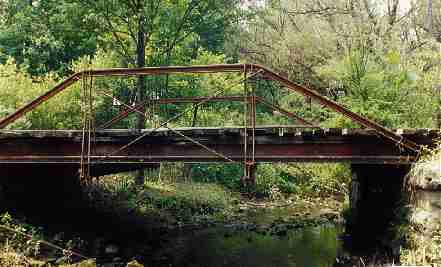Mercer County Engineer's Office
Historic Bridge 2631
|
|||

|
|||
Mercer County Bridge No. 2631 was a structure eligible for the National Register of Historic Places. An Historic Bridge Recordation document was prepared before replacement of this structure. It was located in a thinly settled rural area along Cribbs Road in Findley Township, Mercer County, Pennsylvania. The bridge was situated two miles east of the settlement of Hope Mills, approximately 300 feet south of the junction of Cribbs Road and Road T403. The bridge spanned Pine Run, a tributary of Neshannock Creek. Mercer County Bridge dockets indicate that construction of the original bridge was authorized on July 7, 1893. According to an April 19, 1895 Supplement to the Mercer Dispatch and Republican, monetary disbursements for two separate iron bridges across Pine Run in Findley Township were authorized in 1894. These were in the amounts of $170.00 and $333.00. The Supplement also records the disbursement of $345.00 for bridge stonework across Pine Run. Although it remains unclear which of these references relates to County Bridge No 2631, they do support an 1894 construction date for the bridge. Mercer County Bridge No. 2631 was a steel stringer bridge; reminiscent of the Pratt pony truss type. The bridge was unusual for its use of railway iron and was built in 1894. Although the bridge manufacturer was unknown, the structure may have been built by the Lane Bridge Works of Painted Post, New York, which specialized in the fabrication of bridges using railway iron. Single-span Mercer County Bridge No. 2631 consisted of an I-beam superstructure that utilized railway iron for its upper and lower chords. The bridge rested on stone abutments, and measured 27.3 feet in length and had a cartway width of 11.75 feet. The abutments measured approximately 14 feet in length and seven feet in height and consisted of six courses of elaborately dressed sandstone blocks. The timber plank deck measured 28 feet in length, 12.45 feet in width and was supported by a series of seven longitudinal steel I-beam stringers. These stringers rested on two perpendicular steel floor beams. The upper portion of the bridge consisted of a single central panel (measuring nine feet wide) and two triangular end-panels (each approximately eight feet wide). The upper chord consisted of a single railway iron rail that had been bent at 45-degree angles to form the end-posts of the bridge. The lower chord was also rail iron and rested directly upon the abutments and both floor beams. At each end of the bridge, the upper and lower chords were fastened together by means of threaded U-bolts. These join-points rested directly atop the abutments, without any formal bearing seat. Structural rigidity along the vertical plane of the bridge was provided through a series of parallel, threaded vertical rods that looped around the upper chord of the bridge and connected to each floor beam. Along each elevation, each floor beam was also connected to the upper chord by means of a single diagonal torsion rod. A series of six crisscrossing lateral braces beneath the bridge deck provided torsional strength along the horizontal plane of the bridge. Mercer County Bridge No. 2631 was a unusual example of the many small-scale rural bridges built throughout Pennsylvania and other states during the late nineteenth and early twentieth century. |